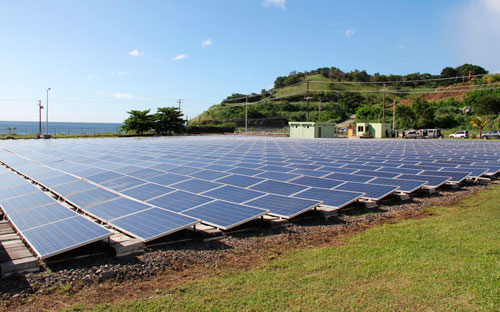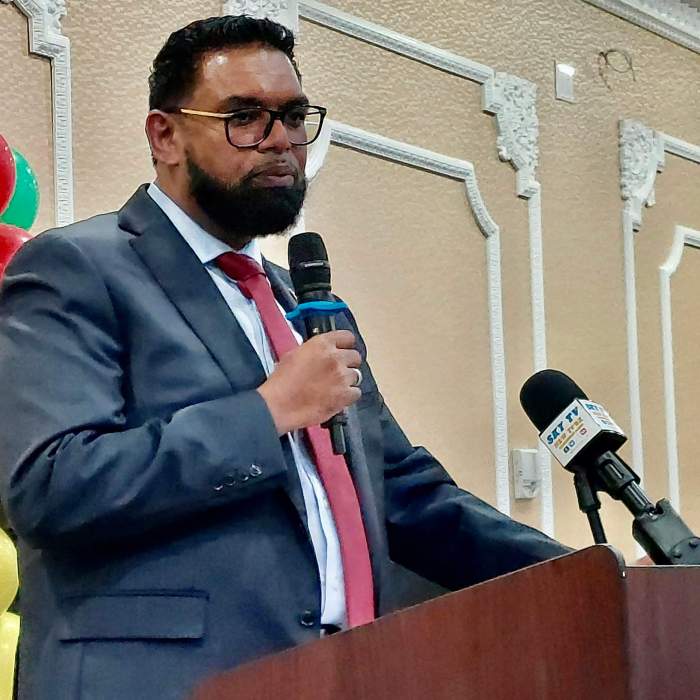KINGSTOWN, Jan. 12, 2015 (IPS) – For decades, the fertile slopes of La Soufriere volcano, which occupies the northern third of this 344-kilometre-square island, has produced illegally grown marijuana that fuels the local underground economy, and the trade in that illicit drug across the eastern Caribbean.
But now the 1,234-metre-high mountain, which last erupted in 1979, is now being explored for something very different — its geothermal energy potential.
The Ralph Gonsalves government believes that geothermal energy will be a “game changer” for the local economy.
In this country, where tourism is the mainstay, the cost of electricity ranges from 40 to 50 cents per kilowatt-hour — several times what consumers pay in the United States.
Householders and manufacturers are hoping that the geothermal energy exploration, which has been underway for more than a year, will in fact produce the 10 to 15 megawatts of electricity that the country desperately needs to relieve its dependence on high-cost fossil fuels and give new life to the manufacturing and agro-processing sectors.
The geothermal energy exploration is a partnership between the Unity Labour Party government, the Icelandic Firm Reykjavik Geothermal Ltd., and Emera Inc., an international energy company with roots in Nova Scotia, Canada that also owns power stations in the Caribbean.
One year after the geothermal project was launched, Prime Minister Gonsalves, who will run for a fourth consecutive five-year term in elections this year, told Parliament in December that the geothermal power plant is on track for a 2017-2018 completion.
By June 2015, a technical report will be completed and well and plant site selection will be done, Gonsalves, who also holds the energy portfolio, told lawmakers.
“We are still on target. I have been advised by the Energy Unit. … Barring some extraordinary challenge which may arise, we should be having a production of 10 megawatts by the end of 2017,” Gonsalves told lawmakers.
The “very low interest monies” that the prime minister says his government will receive shortly may have been a reference to his government’s application for a 15-million-dollar loan through the Abu Dhabi Fund for Development and the International Renewable Energy Agency (IRENA).
The successful applicants will be announced at the Fifth Session of the IRENA Assembly, slated for Jan. 17-18 in Abu Dhabi, which Gonsalves will attend.
Putting the loan application of St. Vincent and the Grenadines into context, Gonsalves told IPS, “There are about 80 applications from which they are choosing eight, and the total sum would be 60 million [dollars] overall … which they will lend in this particular year.”
Notwithstanding falling oil prices recently, Gonsalves is still convinced that renewable energy is the way to go for St. Vincent and the Grenadines.
“In days gone by, when diesel was 15 dollars or less per barrel, there was no real urgency to address the other forms of energy,” he tells IPS.
One-quarter of the 20 megawatts of electricity generated during peak demand in this multi-island nation comes from the country’s three hydropower plants. The remaining 15 megawatts is generated by diesel, 70 million dollars worth of which was imported in 2013 for electricity generation.
“We want to make the hydro plants more efficient … and we want to do solar, and we are doing solar, and we want to do geothermal,” Gonsalves tells IPS, adding that geothermal energy can carry a base load of 98 per cent of the country’s energy needs, whereas solar could possibly generate 20 per cent — or higher with improved technology.
“So, even if you have a lot of solar, you are still going to need the hydro and the geothermal and the diesel to carry the base,” he tells IPS, adding that the country has a good geothermal source.
Among those who are hoping that the geothermal power plant becomes a reality sooner than later is 52-year-old furniture manufacturer Montgomery Dyer, who lives in Spring Village, a community in North Leeward, the district in northwestern St. Vincent, where the volcano is partly located.
Dyer tells IPS that he is excited about the prospects of lower electricity bills, as the cost of energy represents some 10 per cent of the production cost at his business, which employs 28 persons.
“The cost of energy in St. Vincent is very high. In any way we can reduce the cost of energy, the production cost will go down,” he tells IPS, adding that a spinoff effect would be increased competitiveness.
“We will be in a better position to compete, simple as that,” he says, even as he notes that the relatively high labour cost is also a challenge.
Dyer pays some 1,100 dollars for electricity each month, a substantial amount that would be even higher had he not taken steps to reduce electricity consumption at the factory.
“The factory is a mechanised factory, so everything [runs on] power. We try to use machines with smaller motors, and machines that rely on pneumatics. In any case, the compressor has to generate the air to power the machines where pneumatics are required,” he explained.
Outside of geothermal and hydropower, St. Vincent and the Grenadines is already taking steps to cash in on the warm tropical sunshine that bathes the nation almost year-round.
The country has some 750 kilowatt hours of photovoltaic installations, including a 10 kilowatt-hour installation on the Financial Complex — which houses the Office of the Prime Minister — that has seen the cooling cost at that building slashed by some 20 per cent.
Most of the solar installations are owned by the state electricity company, St. Vincent Electricity Services Ltd. (VINLEC), which has a legal monopoly on the commercial generation and distribution of electricity.
VINLEC has 557 kilowatt-hours of solar photovoltaic panels at its Cane Hall Power Plants, east of Kingstown, and another in Lowmans Bay, west of the capital, where another diesel power plant is also located.
The state-owned company has invested one million dollars in the panels, but the impact on the size of consumer’s electricity bill is expected to be negligible — a few cents annually.
All of the solar panels installed across the country, however, are expected to reduce by 800 tonnes annually the amount of greenhouse gases that St. Vincent and the Grenadines emits into the atmosphere.
“Now, 800 tonnes is not a significant number in global terms, but what it points to is that we are making our contribution as a small island developing state, and it is in that context of the geothermal that this visit arises,” Prime Minister Gonsalves says.
Greenhouse gases are a primary driver of climate change, which has resulted in several — sometimes unseasonal — severe weather events in St. Vincent and the Grenadines over the past few years.
These include a trough system on Christmas Eve 2013 that claimed 12 lives, and left loss and damages of 122 million dollars, or 17 per cent of the gross domestic product, according to government estimates.
Furniture manufacturer Dyer lost 445,000 dollars as a result of that trough system and had to borrow “hundreds of thousands of dollars” from commercial banks to restart his business some months later.
“It destroyed the factory,” he told IPS. “The water came through the factory — created a river in on section of the factory. It washed out everything on one side and deposited about 50 truckloads of stone, sand, and debris in the factory.
“It left the machines under about two feet of mud and silt,” he said. “It was crippling.
Edited by Kitty Stapp




















